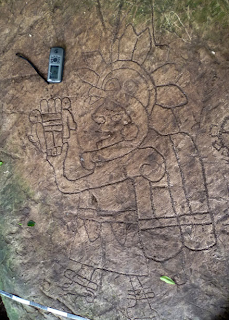Written by the TreasureGuide for the exclusive use of treasurebeachesreport.blogspot.com.
 |
| Long before The Simpsons were on TV there was... Photo from the ArtDaily article linked at the left. |
Seriously though, is there reason to believe they didn't do cartoons? Surely they had a sense of humor too. I would bet on it.
When I looked at this petroglyph, that's the first thing I thought of. Could it be a cartoon? Forget the jet pack on his back. And the artifact in his hand. Maybe he was the first archie.
See if you can win the Name the Petroglyph contest. Send me your names for this fellow.
If you want to read the article about this recently discovered 500 year-old petroglyph from Veracruz, here is the link. Warning: It won't be as much fun as this post.
http://www.artdaily.com/index.asp?int_sec=2&int_new=62110#.UXq0aSDD_IV
When did the Phillip's head screw come into common useage? I'll answer that below.
You might be wondering why you should care. Here is my answer to that. It is good to be able to get an estimate of the time period of your finds when you are in the field. That can give you some idea about what other items might be found in the same area. Of course, some times there will be items from widely varying dates in the same area. Nonetheless, older items are a good sign. I'd gnerally rather dig an old coin than a new one. It means there is a good chance that you are getting into older layers of sand and older materials, and you might be getting to an area where things have been accumulating for some time.
The bolt I posted yesterday is what is called a carriage bolt. John L and Eric L. both wrote to provide that information. It helped me more than you might expect because I had the right word to use for internet searches. In the process I learned a lot about screws.
Even though screws go back to the 1500s and beyond, Phillips Head screws were first commonly used in the 1930s.
Fasteners, including nails, spikes, etc. are some of the most common items you will find, especially at sites associated with shipwrecks or old buildings. They will therefore be one of the things that you can help you associate a site with a time period.
They will be especially plentiful in areas where there were camp fires created from beach debris, such as shipwreck wood.
There was a time when I thought screws were always very modern and paid no attention to them.
Here is a good article on the manufacture of wood screws, mostly from the 1800s. It includes a lot of exceptionally good pictures and tells you how to recognize old screws.
www.cool.conservation-us.org/coolaic/sg/wag/Am_Wood_Screws.pdf
And here is another.
http://www.worthpoint.com/blog-entry/screws-identify-age-furniture
About 1848 screws took on a form that makes them look very much like they do today.
Here are some things to look for to identify old screws.
Older screws often shows evidence of filing on the head. The slot is often off-center. The screw does not end in a point. The threads are more irregular. You will find a few other things to look for if you read both of the above articles.
By the way, iron objects that were burned seem to survive salt corrosion better than those that were not burned. Those imbedded in the wood are also more protected and tend to be better preserved.
If you do find some old iron or wood on the beach, the first thing is to soak it to get the salts out. Some people say to use rain water or purified water for soaking the item. Tap water can contain chemicals. So the first thing to do with items like that is to put them in a pure water bath and keep them there, occasionally changing the water. Again, the Texas A&M conservation lab provides great information on the internet about the treatment of all kinds of objects.
 |
| Small Gold Ring Beach Find. |
Even though it is small, it is quality. Nice stone and 18k gold.
Smaller gold like this can easily be missed if you aren't careful either with your detector settings or if your sweep is too fast or too high.
Another beautiful day on the Treasure Coast. The surf is around 2 - 4 feet. The wind will be shifting later today.
The surfing web site is predicting 4 - 7 foot seas for Sunday. I have been watching that closely. I'm a bit surprised that the upper limit of 7 feet has stood up. And glad that it did.
Tues is supposed to be just a little less.
Unfortunately, the wind on Sunday is expected to be mostly east. To bad it isn't from the north or northeast. We'll see how that works out.
Today low tide on the Treasure Coast will be around 3 PM.
Happy hunting,
TreasureGuide@comcast.net